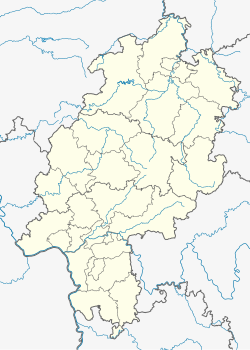Fulda
Fulda (IPA: [ˈfʊlda]) is a city in Hesse, Germany; it is on the Fulda River and is the administrative seat of the Fulda district (Kreis).
Fulda | |
|---|---|
 Castle of Fulda | |
| Coordinates: 50°33′3″N 9°40′31″E / 50.55083°N 9.67528°E | |
| Country | Germany |
| State | Hesse |
| Admin. region | Kassel |
| District | Fulda |
| Founded | 744 |
| Government | |
| • Lord mayor | Dr. Heiko Wingenfeld (CDU) |
| Area | |
| • Total | 104.04 km2 (40.17 sq mi) |
| Elevation | 261 m (856 ft) |
| Population (2022-12-31)[1] | |
| • Total | 69,968 |
| • Density | 670/km2 (1,700/sq mi) |
| Time zone | UTC+01:00 (CET) |
| • Summer (DST) | UTC+02:00 (CEST) |
| Postal codes | 36001–36043 |
| Dialling codes | 0661 |
| Vehicle registration | FD |
| Website | www |
History
changeEarly Middle Ages
changeThe Benedictine monastery of Fulda was founded in 744 by Saint Sturm, a disciple of Saint Boniface, when Boniface was reorganising the church in Germany.
From its foundation, the abbey Fulda and its territory was subject only to the German emperor, not to the control of the local lords. Fulda was made a bishopric in 1752 and the prince-abbots were given the additional title of prince-bishop. The prince-abbots (and later prince-bishops) ruled Fulda and the surrounding region until the bishopric was forcibly dissolved by Napoleon in 1802.
From 1764 until 1789 Fulda had a porcelain factory. Because of its quality and rarity, it is much prized by collectors. The factory was begun under Prince-Bishop, Prince-Abbot Heinrich von Bibra and closed down shortly after his death by his successor, Prince-Bishop, Prince-Abbot Adalbert von Harstall.
Stiffoller
changeArround 1717-1804, People from Stift Fulda went to Hungary, and settled especially in the Komitat Baranya. This subgroup of the Danube Swabians are called Stifolder or Stiffoller,[2] There is also a street named the Stiffollerweg in Petersberg near Fulda[3]
Rulers of Fulda until Secularization
changeAbbots
- St. Sturmius 744-779
- Baugulf 779-802
- Ratgar 802-817
- Eigil of Fulda 818-822
- Rabanus Maurus 822-842
- Hatto I 842-856
- Thioto 856-869
- Sigihart 869-891
- Huoggi 891-915
- Helmfried 915-916
- Haicho 917-923
- Hiltibert 923-927
- Hadamar 927-956
- Hatto II 956-968
- Werinheri 968-982
- Branthoh I 982-991
- Hatto III 991-997
- Erkanbald 997-1011
- Branthoh II 1011-1013
- Poppo 1013-1018, also Abbot of Lorsch (Franconian Babenberger)
- Richard 1018-1039
- Sigiwart 1039-1043
- Rohing 1043-1047
- Egbert 1047-1058
- Siegfrid I von Mainz (Sigfried von Eppenstein) 1058-1060
- Widerad von Eppenstein 1060-1075
- Ruothart 1075-1096
- Godefrid 1096-1109
- Wolfhelm 1109-1114
- Erlolf of Bergholz 1114-1122
- Ulrich of Kemnaten 1122-1126
- Heinrich I of Kemnaten 1126-1132
- Bertho I of Schlitz 1132-1134
- Konrad I 1134-1140
- Aleholf 1140-1148
- Rugger I 1148
- Heinrich II of Bingarten 1148-1149
- Markward I. 1150-1165
- Gernot of Fulda 1165
- Hermann 1165-1168
- Burchard Graf von Nürings 1168-1176
- Rugger II 1176-1177
- Konrad II 1177-1192
- Heinrich III of Kronberg im Taunus 1192-1216
- Hartmann I 1216-1217
- Kuno 1217-1221
Prince-Abbots
- Konrad III von Malkes 1221-1249
- Heinrich IV von Erthal 1249-1261
- Bertho II von Leibolz 1261-1271
- Bertho III von Mackenzell 1271-1272
- Bertho IV von Biembach 1273-1286
- Markward II von Bickenbach 1286-1288
- Heinrich V Graf von Weilnau 1288-1313
- Eberhard von Rotenstein 1313-1315
- Heinrich VI von Hohenberg 1315-1353
- Heinrich VII von Kranlucken 1353-1372
- Konrad IV Graf von Hanau 1372-1383
- Friedrich I von Romrod 1383-1395
- Johann I von Merlau 1395-1440
- Hermann II von Buchenau 1440-1449
- Reinhard Graf von Weilnau 1449-1472
- Johann II Graf von Henneberg-Schleusingen 1472-1513
- Hartmann I Burggraf von Kirchberg 1513-1521/29
- Johann III. Graf von Henneberg-Schleusingen 1521/29-1541
- Philipp Schenk zu Schweinsberg 1541-1550
- Wolfgang Dietrich von Eusigheim 1550-1558
- Wolfgang Schutzbar (named Milchling) 1558-1567
- Philipp Georg Schenk zu Schweinsberg 1567-1568
- Wilhelm Hartmann von Klauer zu Wohra 1568-1570
- Balthasar von Dernbach (nanmed Grauel) 1570-1576, 1602-1606
- Johann Friedrich von Schwalbach 1606-1622
- Johann Bernhard Schenk zu Schweinsberg 1623-1632
- Johann Adolf von Hoheneck 1633-1635
- Hermann Georg von Neuhof (named Ley) 1635-1644
- Joachim Graf von Gravenegg 1644-1671
- Cardinal Gustav Adolf (Baden) (Bernhard Gustav Markgraf von Baden-Durlach) 1671-1677
- Placidus von Droste 1678-1700
- Adalbert I von Schleifras 1700-1714
- Konstantin von Buttlar 1714-1726
- Adolphus von Dalberg 1726-1737
- Amand von Buseck, 1737-1756, Prince-Bishop starting 1752
- Adalbert II. von Walderdorff 1757-1759
- Heinrich VIII. von Bibra, 1759-1788
- Adalbert von Harstall, 1789-1814, Prince-Bishop until 1802
People
changeRelated pages
change- Annales Fuldenses (The Annals of Fulda)
- Diocese of Fulda
- Flora fuldensis (The Flowers of Fulda)
- Ludwig Fulda (Fulda pedigrees)
- Fulda Symphonic Orchestra
- Fulda River
- Fulda (district)
- Fulda, Minnesota
References
changeOther websites
changeMedia related to Fulda at Wikimedia Commons
- Official website of the city
- 360degree virtual tour through downtown Fulda Archived 2018-10-04 at the Wayback Machine
- Vonderau Museum Fulda
- Hochschule Fulda (University of Applied Science) Archived 2015-11-29 at the Wayback Machine
- Institut of interdisziplinary Research - inter.research e.V. Archived 2021-03-23 at the Wayback Machine




